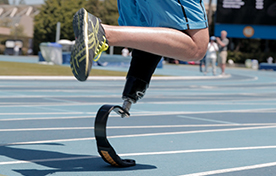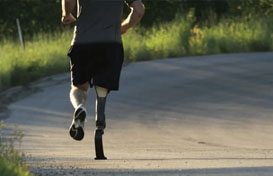Running for Coverage
– by Élan Young
The U.S. Department of Agriculture estimates that in 2004, low-income families spent $184,320 per child from birth to age 17. For middle and high-income families, cost estimates per child range from $284,460 to $500,000. These numbers confirm what parents already know: Raising kids is expensive.
It’s hard to be prepared for the times when expenses come from unforeseen medical needs. Therapies, multiple surgeries and medical equipment costs vary, but parents faced with these challenges are increasingly forced to dig deep within their own pockets to fill coverage gaps.
Needing prosthetic care for the first time often coincides with crisis, and before they know it, the family is dealt a second blow – this time, financial. It’s devastatingly common for new amputees and their families to learn too late that their prosthetic coverage is lacking or was cut altogether, because, unknown to them or the employers who offered the plan, the devilish details of prosthetic coverage are buried in the fine print. Increasingly, prostheses are lumped in with durable medical equipment that includes lower-priced items such as walkers and wheelchairs. When insurance companies cap costs for this equipment at $2,500 in exchange for a lower premium, it seems like a good deal – until a child needs a prosthesis costing upwards of $40,000.
High-dollar prostheses create financial pressure for many amputees, but none more so than for families of amputee children. “Some insurance companies limit coverage to one prosthesis per lifetime,” says Morgan Sheets, national advocacy director for the Amputee Coalition of America (Amputee Coalition). “Even at 25 or 55 years old, the expectation of using only one limb is absurd. For kids, it is truly a tragedy.”
Children will outgrow a prosthesis every couple of years. If prosthetic coverage is lacking, families must fight for it, reach out for funding elsewhere, front the money themselves, or do without.
Even when adequate coverage is granted, parents don’t stop worrying about their children’s prosthetic needs – since employers are free to switch health plans, jobs can change at a moment’s notice, and children will only be covered under their parents’ plans for so long. Each family faces a different set of circumstances. But what’s common among parents of children with limb loss is weariness, frustration and fear about medical insurance coverage, as well as a resilience that helps them survive in the face of tough choices.
What’s in a Plan?
When 9-year-old Sean Brame broke his ankle in a soccer game and then came down with flu-like symptoms, no one expected the traumatic chain of events that followed. Sean was rushed to the hospital with a 105° fever. His body was fighting a serious bacterial infection that led to septic shock (low blood pressure and poor circulation) and multiple organ failure. His doctors didn’t think he’d survive. He lived, but lost his legs below the knee, his right hand, and all but one finger on his left hand, which Sean calls his “lucky finger.”
After 15 weeks in a pediatric hospital, Sean emerged a fighter, ready to resume a normal life. Now 12, he enjoys a dizzying whirl of activities – from Boy Scouts to acting in a school play, he inspires people wherever he goes. He was recently selected as the 2008 Pennsylvania representative for Champions Across America to be an international ambassador for the Children’s Miracle Network hospitals.
Sean’s mother, Carol, knows she’s lucky that her son survived, but she also realizes now how lucky she is to have great prosthetic coverage through her employer. “I had no clue what our coverage was,” says this school teacher. “In fact, it was not spelled out in the paperwork.”
Sean’s prosthetic legs are covered with no lifetime limit. Such allowances are rare.“My union representative called the insurance company and made darn sure the language was included,” she adds. But even now she wonders how life will change for Sean once he turns 21 and is bumped off the family’s health insurance plan.
But it’s not just this distant date that worries her. The fear creeps back every 3 years when her teaching contract is renegotiated.“Insurance parity is still important to me,” she says. “What if my coverage changes?”
When Push Comes to Shove
In 2005, when Samantha was 18 months old, she was adopted by Susan and Marc Fraser. As a child with an above-knee congenital limb difference, she needs a prosthesis to walk. The family experienced virtually no problems in obtaining Samantha’s first prosthesis, and she learned to walk with it in only 5 weeks. Samantha began to outgrow her leg 18 months later, but the family health insurance had changed.
The Frasers’ prosthetists had not worked with this insurance company before, and the amount and detail of information required baffled them. When they submitted the request with a breakdown of costs for the parts, it was denied. They kept getting letters saying that Samantha’s prosthesis was not medically necessary. The prosthetists told the Frasers they needed to step in.
It took six phone calls before Marc reached a live person in the arbitration department of the insurance company. He finally reached someone who seemed helpful – she didn’t understand why the claim had been denied.
But even with an ally in the company, their problems didn’t stop. The paperwork to reverse the denial was filed, and the Frasers spent another 45 days leaving phone messages. “It reached the point where I was telling them that Samantha would be crawling in a few weeks,” says Marc.
Eventually, they received approval for 95 percent of their request.
“The insurance companies need to be educated about what constitutes a normal prosthesis,” says Susan. The word “custom” caused the confusion.
“They thought we could get a leg off the shelf, but what they didn’t understand is that every socket is custom-made to fit an individual’s residual limb,” says Marc. “I’m sure they had to think long and hard about approving our claim, since now they have to continue approving claims like this for everyone.”
The Kindness of Strangers
In an orphanage in Kazakhstan, Dee Thompson told her soon-to-be son Michael that he would have a prosthetic arm in the U.S. Dee was thrilled with the thought of expanding her family, and affording a prosthesis was the furthest thing from her mind. When her then 10-year-old son came home with her, she sought out a prosthetist who could fit him with a myoelectric arm.
Michael had a blast trying out different arms and fittings at the hospital. “After that, Michael would ask me every day, ‘When is my arm going to be ready?’” Dee recalls. She knew that Michael could get by without the prosthetic arm, but when she saw how thrilled he was during the fittings, she knew she had to make it happen. The only problem was the cost.
Dee’s employer has an agreement with the health insurance company to cover adopted children regardless of preexisting conditions, so it was a surprise to her that her provider was only going to pay for the plastic sheath that fits over the mechanical parts. She would have to come up with about $15,000 on her own – no small sum for a single mother of two.
“I was thinking it would cost between $3,000 to $10,000 for a prosthesis,” Dee says. “I was absolutely shocked when I found out the actual cost was closer to about $30,000.” Instead of fighting the company, Dee reached out to Shriners Hospitals for Children. Her request went to the Inner Wheel U.S.A. Foundation, a group dedicated to helping families obtain myoelectric arm prostheses.
“If it weren’t for Inner Wheel, I don’t know how we would have made this happen,” she admits. “I would have been devastated. Maybe I would have put a second mortgage on my house.”
Dee, who chronicles the family’s growth on her blog (deescribbler.typepad.com/ my_weblog), is deeply invested in making sure her children have what they need to succeed. “Michael functions extremely well without a prosthesis, but I want him to have an option,” she says. “He’s already grown 5 inches and gained 18 pounds since coming over here; it’s hard to say how many arms he’ll need before he stops growing.”
Fighting for Parity Pays Off
The cost of Evan Light’s latest pair of prosthetic legs is $22,000, but his family reaches their $4,000 insurance cap with liners alone. Evan, who is on his fifth pair of legs, uses arm liners with a locking pin since his legs are so small, but they aren’t designed for the wear-and-tear from an active, 8-year-old boy. Evan goes through three pairs of liners per year, and each liner costs $800. This is one reason why Evan’s father, Randy Light, decided to become involved in the Amputee Coalition’s campaign for prosthetic parity in Indiana.
The Lights testified before the Indiana Senate Committee on Health and Provider Services to demonstrate how important Evan’s prostheses are. “We wanted them to see what an active, functioning child he is,” recalls Randy. At the meeting, Randy set one of each of Evan’s previous legs on a table so that the progression looked like a bar chart.
Putting a face to the child was a smart move; on March 21, Indiana became the ninth state to sign prosthetic parity into law. On July 1, 2008, the Lights’ insurance policy was amended to include prosthetic care payable at Medicare levels. Even though they will still have to pay a $4,000 out-ofpocket deductible, that will be their maximum amount now instead of the insurance company’s. For a family with five children, this is welcome relief.
Unfortunately, many families with children who have limb loss and limb difference cannot afford the cost of prosthetic care as the child grows. “Imagine if you were fit with a pair of shoes at 5 years old,” Sheets says, “and you were told that you had to wear those shoes for the rest of your life.”
Derrick Stowell, Amputee Coalition’s Youth Activities Program coordinator, has seen the toll that lack of insurance coverage has on the families who attend the Amputee Coalition Annual Youth Camp. “We’ve had campers arrive with parts from their prosthesis literally falling off,” he says. “Sometimes it limits their involvement in camp activities.” This is one reason why the Amputee Coalition is committed to keeping costs as low as possible for the youth camp and to provide scholarships to families in need.
For many families, the dire financial burden will be partially relieved with the passage of the federal Prosthetic Parity Act of 2008 (HR 5615). Sheets notes that new legislation will be a vehicle for increasing attention on quality of life issues.
“Prosthetic parity legislation ensures that the tragedy of children living without a limb is not compounded by forcing them to spend the rest of their childhood in a wheelchair when help is readily available,” she says.
At heart, it’s about fairness.
No funding from the Centers for Disease Control & Prevention (CDC) is used to support Amputee Coalition advocacy efforts. The views represented in this article do not necessarily represent the views of the CDC.
Disclaimer: The following information is provided and owned by the Amputation Coalition of America and was previously published on the website http://www.amputee-coalition.org or the Coalitions Newsletter, inMotion.








